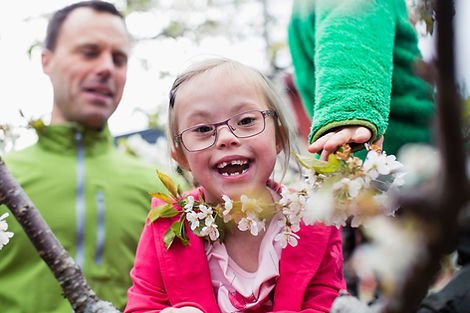KENNEDY HIGH SCHOOL
Transforming lives

P.R.I.D.E.
POSITIVE, RESPECTFUL,
INTEGRITY, DETERMINATION, EXCELLENCE
A Unique Learning Experience
Welcome to our public institution for students with Learning Disabilities, ELLs, Gifted and At-Risk learners, where we provide the best education for our students. Visit our site https://www.kennedyhschicago.org/ to learn more about our teaching methods, staff, and unique community
GIFTED LEARNERS
Accommodations/Modifications: Visuals, Graphic Organizers, Vocabulary (Synonym/Antonyms), Kinesthetic Learning, Funds of Knowledge, Collaboration & Cooperation (Leadership Role), Comprehension Questions, Advanced Readings, Portfolios, Advanced Courses.
This definition of giftedness is the broadest and most comprehensive and is used by many school districts. It speaks of talent, which includes all areas of a child’s life: academic, artistic, athletic, and social. Most schools limit their definition and their programs to academics, but it is important to focus on performance and accomplishment. It is not enough to just have the talent; you must be using that talent to achieve at remarkably high levels. However, this definition does also recognize that while all very talented students have the potential to achieve at high levels, some may not have yet realized or demonstrated that potential. Such students may be underachievers, twice exceptional, or represent underserved groups who have not had a nurturing environment to bring out those talents. Finally, this definition is a comparative one; these students achieve or have the potential to achieve at levels way above their peers.


ENGLISH LANGUAGE LEARNERS
Accommodations/Modifications: Use of Native Language (L1), Visuals, Graphic Organizers, Preview Vocabulary, Kinesthetic Learning, Extended Time, Funds of Knowledge, Collaboration & Cooperation, Comprehension Questions, BICS vs. CALP.
English-language learners, or ELLs, are students who are unable to communicate fluently or learn effectively in English, who often come from non-English-speaking homes and backgrounds, and who typically require specialized or modified instruction in both the English language and in their academic courses. Possible programs for ELLs: Shelter Instruction, Transitional Bilingual Education (TBE), or Dual-Language Education.
CATEGORIES OF DISABILITY UNDER IDEA


AUTISM
July 2021
1. Autism
…means a developmental disability significantly affecting verbal and nonverbal communication and social interaction, generally evident before age three, that adversely affects a child’s educational performance. Other characteristics often associated with autism are engaging in repetitive activities and stereotyped movements, resistance to environmental change or change in daily routines, and unusual responses to sensory experiences. The term autism does not apply if the child’s educational performance is adversely affected primarily because the child has an emotional disturbance, as defined in #5 below.
A child who shows the characteristics of autism after age 3 could be diagnosed as having autism if the criteria above are satisfied.
Accommodations/Modifications: Extra Breaks, Daily Outlines, Assistive Technology, Quiet Corner, Visuals, Kinesthetic Learning, Collaboration & Cooperation, Funds of Knowledge, Social Skills Learning, One on One instruction (when possible)
DEAF-BLINDNESS
July 2021
2. Deaf- Blindness
…means concomitant [simultaneous] hearing and visual impairments, the combination of which causes such severe communication and other developmental and educational needs that they cannot be accommodated in special education programs solely for children with deafness or children with blindness.
Accommodations/Modifications: Extended Time, Braille, Large Print, Assistive Technology, Tactile Graphics, Kinesthetic Learning, Models, Audiotape Materials, Highlighting, Reduction of Assignments


DEAFNESS
July 2021
3. Deafness
…means a hearing impairment so severe that a child is impaired in processing linguistic information through hearing, with or without amplification, that adversely affects a child’s educational performance.
Accommodations/Modifications: Sign Language, Assistive Listening Devices, Captioning, Assistive Technology, Preferred Sitting, Kinesthetic Learning, Modified reading & writing, Buddy System, Visuals, Reduction of Assignments
DEVELOPMENTAL DELAY
July 2021
4. Developmental Delay
…for children from birth to age three (under IDEA Part C) and children from ages three through nine (under IDEA Part B), the term developmental delay, as defined by each State, means a delay in one or more of the following areas: physical development; cognitive development; communication; social or emotional development; or adaptive [behavioral] development.
Accommodations/Modifications: Visuals, Daily Routine, Clear & Repetitive Instructions, Collaboration & Cooperation, Alternate between Preferred & less preferred Activities, Assistive Technology, Preferred Sitting, Kinesthetic Learning, Modified reading & writing, Social Skills Learning


EMOTIONAL DISTURBANCE
July 2021
…means a condition exhibiting one or more of the following characteristics over a long period of time and to a marked degree that adversely affects a child’s educational performance:
(a) An inability to learn that cannot be explained by intellectual, sensory, or health factors.
(b) An inability to build or maintain satisfactory interpersonal relationships with peers and teachers.
(c) Inappropriate types of behavior or feelings under normal circumstances.
(d) A general pervasive mood of unhappiness or depression.
(e) A tendency to develop physical symptoms or fears associated with personal or school problems.
The term includes schizophrenia. The term does not apply to children who are socially maladjusted, unless it is determined that they have an emotional disturbance.
Accommodations/Modifications: Set up BIP (Behavior Intervention Plan), Constant Positive Feedback, Allow stress relievers, Private Space, Extended Time, Positive Reinforcements, Graphic Organizers, Break large assignments into small segments, Provide Checklist/charts, Verbal/Visuals Cues
INTELLECTUAL DISABILITY
July 2021
…means significantly subaverage general intellectual functioning, existing concurrently [at the same time] with deficits in adaptive behavior and manifested during the developmental period, that adversely affects a child’s educational performance.
(Editor’s Note, February 2011: “Intellectual Disability” is a new term in IDEA. Until October 2010, the law used the term “mental retardation.” In October 2010, Rosa’s Law was signed into law by President Obama. Rosa’s Law changed the term to be used in future to “intellectual disability.” The definition of the term itself did not change and is what has just been shown above.
Accommodations/Modifications: Extended Time, Positive Reinforcements, Graphic Organizers, Kinesthetic Learning, Modified reading & writing, Visuals, Collaboration & Cooperation, Assistive Technology, Oral Testing, Breaks between Tasks


MULTIPLE DISABILITIES
July 2021
…means concomitant [simultaneous] impairments (such as intellectual disability-blindness, intellectual disability-orthopedic impairment, etc.), the combination of which causes such severe educational needs that they cannot be accommodated in a special education program solely for one of the impairments. The term does not include deaf-blindness.
Accommodations/Modifications: Visuals, Daily Routine, Clear & Repetitive Instructions, Collaboration & Cooperation, Alternate between Preferred & less preferred Activities, Assistive Technology, Preferred Sitting, Kinesthetic Learning, Modified reading & writing, Social Skills Learning
ORTHOPEDIC IMPAIRMENT
July 2021
…means a severe orthopedic impairment that adversely affects a child’s educational performance. The term includes impairments caused by a congenital anomaly, impairments caused by disease (e.g., poliomyelitis, bone tuberculosis), and impairments from other causes (e.g.,cerebral palsy, amputations, and fractures or burns that cause contractures).
Accommodations/Modifications: Seating Arrangements, Development of gross & fine motor skills, assistive technology, Extended Time, Positive Reinforcements, Increase size of equipment (materials), Reduction of Assignments, Modified reading & writing, Social Skills Learning, Buddy System


OTHER HEALTH IMPAIRMENT
July 2021
…means having limited strength, vitality, or alertness, including a heightened alertness to environmental stimuli, that results in limited alertness with respect to the educational environment, that—
(a) is due to chronic or acute health problems such as asthma, attention deficit disorder or attention deficit hyperactivity disorder, diabetes, epilepsy, a heart condition, hemophilia, lead poisoning, leukemia, nephritis, rheumatic fever, sickle cell anemia, and Tourette syndrome; and
(b) adversely affects a child’s educational performance.
Accommodations/Modifications: Visuals, Daily Routine, Clear & Repetitive Instructions, Collaboration & Cooperation, Extended Time, Assistive Technology, Preferred Sitting, Kinesthetic Learning, Modified reading & writing, Social Skills Learning
SPECIFIC LEARNING DISABILITY
July 2021
11. Specific Learning Disability
…means a disorder in one or more of the basic psychological processes involved in understanding or in using language, spoken or written, that may manifest itself in the imperfect ability to listen, think, speak, read, write, spell, or to do mathematical calculations. The term includes such conditions as perceptual disabilities, brain injury, minimal brain dysfunction, dyslexia, and developmental aphasia. The term does not include learning problems that are primarily the result of visual, hearing, or motor disabilities; of intellectual disability; of emotional disturbance; or of environmental, cultural, or economic disadvantage.
Accommodations/Modifications: Extended Time, Positive Reinforcements, Graphic Organizers, Kinesthetic Learning, Modified reading & writing, Visuals, Collaboration & Cooperation, Assistive Technology, Oral Testing, Breaks between Tasks


SPEECH OR LANGUAGE IMPAIRMENT
July 2021
12. Speech or Language Impairment
…means a communication disorder such as stuttering, impaired articulation, a language impairment, or a voice impairment that adversely affects a child’s educational performance.
Accommodations/Modifications: Language Therapy, Copy of Notes, Introduce One Concept at a Time, Assistive Technology, Kinesthetic Learning, Modified reading & writing, Visuals, Reduction of Assignments, Clear & Repetitive Instructions, Extended Time
TRAUMATIC BRAIN INJURY
July 2021
…means an acquired injury to the brain caused by an external physical force, resulting in total or partial functional disability or psychosocial impairment, or both, that adversely affects a child’s educational performance. The term applies to open or closed head injuries resulting in impairments in one or more areas, such as cognition; language; memory; attention; reasoning; abstract thinking; judgment; problem-solving; sensory, perceptual, and motor abilities; psychosocial behavior; physical functions; information processing; and speech.
The term does not apply to brain injuries that are congenital or degenerative, or to brain injuries induced by birth trauma.
Accommodations/Modifications: Alter Classroom Environment, Checklist, Simple & Multiple Examples, Clear Directions, Do not Shout, Verbal Praise & Encouragement, Extended Time, Limit Requests, Look at Student when giving Instructions, Visuals


VISUAL IMPAIRMENT INCLUDING BLINDNESS
July 2021
14. Visual Impairment Including Blindness
…means an impairment in vision that, even with correction, adversely affects a child’s educational performance. The term includes both partial sight and blindness.
Accommodations/Modifications: Braille, Large Print, Assistive Technology, Oral Testing/Scribing, Copies of Notes, Verbal Information, Extended Time, Reduction of Assignments, Preferred Sitting, Allow Movement in the Classroom.
"ADVERSELY AFFECTS"
July 2021
You may have noticed that the phrase “adversely affects educational performance” appears in most of the disability definitions. This does not mean, however, that a child has to be failing in school to receive special education and related services. According to IDEA, states must make a free appropriate public education available to “any individual child with a disability who needs special education and related services, even if the child has not failed or been retained in a course or grade, and is advancing from grade to grade."
Serving Diverse Learners in our Communities.

AT RISK LEARNERS/RESPONSE TO INTERVENTION
Accommodations/Modifications: Visuals, Graphic Organizers, Preview Vocabulary, Kinesthetic Learning, Extended Time, Funds of Knowledge, Collaboration & Cooperation, Comprehension Questions, Assistive Technology, Metacognition Strategies.
The term at-risk learner is generally defined as a student who is in danger of failing to complete school with a basic level of academic proficiency. The construct is defined in terms of characteristics situated within the individual, family, and community. Characteristics inherent to the individual include genetic or biological conditions, which can be acquired or congenital (present at birth). Psychological and behavioral concerns are also inherent to the individual student. Within the family, characteristics include race, gender, language, culture, socioeconomic status, abuse, neglect, transience or homelessness, parents’ marital status, and parents’ level of education.
FOR MORE DETAILS, OR TO SCHEDULE A VISIT TO OUR SCHOOL, GET IN TOUCH TODAY.
6325 W 56th St, Chicago, IL 60638
Published by Raul Ventura (rventura@cps.edu)
(773) 535-2325
(773) 535-2485